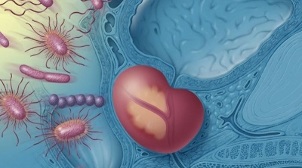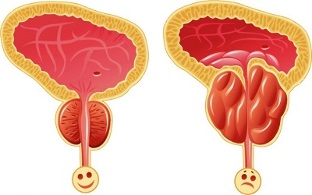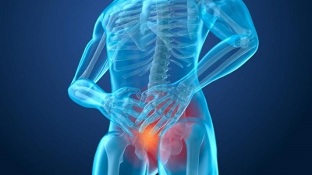
Description of the causes, symptoms, features of diagnosis and treatment of acute or chronic bacterial prostatitis. Recommendations from urologists who will help you quickly identify the disease and contact the clinic in a timely manner to diagnose and prescribe complex therapy.
Prostatitis is one of the most common urological diseases in men. Inflammation of the prostate brings discomfort to life and can lead to sexual weakness.
According to various estimates, between a quarter and a third of the male population after the age of 40 have problems with the prostate. With young people, the statistics are better but still unhappy.
Today we will talk about bacterial prostatitis (BP) and consider the causes of its occurrence, symptoms and features of diagnosis and treatment.
Causes of occurrence
The complexity of Parkinson's disease is that it often progresses in subtle forms and goes undetected for a long time, which delays the start of treatment.
The main cause of bacterial inflammation of the prostate is an infection of the gland, but this not only leads to disease.
Among the causes of bacterial prostatitis we note:
- Sedentary lifestyle.
- Violation of the rhythm in sex life.
- overweight.
- Chronic constipation.
- Alcohol abuse.
To understand how these causes affect the onset and development of pathology, let's consider their specifics.
Microbes and infections regularly get into the prostate. However, this does not always lead to bacterial infection because the immune system is working.
In addition, good blood circulation quickly carries away infections and stimulates local immunity in the area of the gland, thereby preventing infection.
Interesting!With a sedentary lifestyle and irregular sex, prostate obstruction occurs, which is an additional factor in the onset of the disease.
If you have a sedentary job, going to the gym or doing hip exercises at home is a good idea after 40 and earlier.
Obesity and chronic constipation also affect the blood flow in the glandular area. Keep track of your body weight and include high fiber foods in your diet to help prevent constipation.
Alcohol weakens the immune system (with regular abuse), whereby the body's protective barrier is broken and microbes can more easily "gain a foothold" in the prostate.
Remember that bacteriological prostatitis does not appear from scratch. Most often, the disease occurs in people who do not monitor their health.
Disease symptoms
Like any other disease, Parkinson's disease has its own symptoms, the severity of which depends on the stage of the disease and the characteristics of the patient's body.
The most common cause of concern for a person with prostate inflammation is:
- Frequent urination.
- Painful sensations when going to the toilet.
- A feeling of heaviness in the groin.
- Decreased sex drive up to erection problems.
The most pronounced symptoms occur when acute Parkinson's disease develops. If treatment is not started, the disease becomes chronic and the severity of symptoms is smoothed out.
There is no reason to be happy here, as chronic inflammation is more difficult to treat and the therapy requires more time.
Important!If you have the first symptoms of prostatitis, this is a reason to go to a urologist and get a diagnosis, as starting treatment sooner increases the chances of success.
The bacteria that cause prostatitis are microplasma, chlamydia, and other microbes that can enter the prostate via the urine or bloodstream of the primarily infected organ.
Acute prostatitis
In acute form, the patient can even have a temperature rise of up to 40 degrees, as well as the appearance of a fever. Groin pain can be sharp, purulent discharge occurs from the urethra, and the urge to use the toilet is very common.

Acute bacterial prostatitis in men cannot go unnoticed. This is the advantage because the patient goes to the urologist immediately.
In acute form, a strong burning sensation occurs when using the toilet and general irritability and tiredness occur.
If therapy is not started in time, Parkinson's disease can lead to complications:
- An abscess in the body of the prostate.
- vesiculitis.
- colliculitis.
- Scar changes in the prostate.
An abscess, in turn, can rupture the prostate and severely poison the body. Vesiculitis causes pus to appear in the semen and a man's reproductive function can stop.
Colliculitis is no less dangerous, in which a severe pain syndrome develops during sex, which can lead to psychological trauma and impotence.
Scar changes lead to infertility as they reduce the mobility of the sperm and the quality of the sperm. In addition, the narrowing of the urethra with scars makes it difficult to urinate and leads to clogging of the bladder, which may be the reason for the surgeon's intervention.
Chronic form
Chronic bacterial prostatitis is either primary or secondary. In the first case, it develops immediately without an acute phase, in the second it appears as a neglected form of acute inflammation of the prostate.
The symptoms of the chronic phase are more blurred, but they also cause discomfort in the patient:
- Difficulty urinating.
- The urge to go to the toilet increases.
- Erectile function is impaired.
- Burning and heaviness can be felt in the perineal area.
These are the main characteristics of chronic Parkinson's disease. If treatment is not started on time (complex therapy), complications in the following form are possible:
- cystitis.
- Sepsis.
- pyelonephritis.
- Reduced immunity.
The danger of the disease lies precisely in the less pronounced symptoms that men sometimes simply do not pay attention to.
When it is impossible not to notice the acute phase, the chronic inflammatory process is often ignored, and treatment is long and not always effective.
Diagnosis of inflammation

When the first signs of prostatitis appear, you need to go to the doctor, who will prescribe a number of diagnostic measures. They make it possible to determine the presence of inflammation and its nature, which will help in the effective treatment of the disease.
The complete diagnosis includes:
- Digital examination of the prostate.
- Analysis of prostate secretion.
- Cut back on sexually transmitted diseases.
- Ultrasound of the gland.
The doctor may also need a semen analysis and a biopsy to rule out or confirm the presence of cancer in the prostate.
Digital examination of the gland is an uncomfortable but important stage of diagnosis, since the patient is simple, has an uneven density, and is enlarged.
The analysis of the secretion will determine the infectious or non-infectious form of the disease, and the ultrasound will help the doctor identify the contours of the gland. If they are blurry, it is an obvious confirmation of prostatitis.
After the diagnosis, the urologist decides on the treatment of the patient taking into account:
- Type of prostatitis.
- The form of the disease.
- Age of the patient.
- Individual characteristics of the patient.
- The presence of comorbidities.
With the exact diagnosis, you can choose the optimal treatment regimen, and the therapy will show the maximum effect. The more stages the diagnosis requires, the more accurate the diagnosis and the easier it is to prescribe complex therapy.
Treatment of prostate inflammation
The therapy for acute and chronic bacterial prostatitis is different because it requires different doses of drugs and the duration of treatment differs.
Interesting!At the initial stage, it is important to get rid of the symptoms that are unpleasant for the patient, in order to improve the quality of life, after the doctor's task is to completely get rid of the disease, regardless of its form.
Acute prostatitis therapy

In the treatment of acute prostatitis, etiotropic therapy is inevitably prescribed; in the case of a bacterial disease, antibiotics and antimicrobial agents cannot be taken.
The following elements are also assigned:
- painkillers.
- immunostimulants.
- Vitamins with trace elements.
- massage.
Drugs against Parkinson's are selected individually depending on the primary infection and the course of the disease.
Important!Antibiotics and antibacterial agents fight germs, while vitamins and immunostimulants strengthen immunity.
A massage in the pre-acute phase accelerates the excretion of prostate secretions and normalizes the blood flow in the gland.
In the event of an acute course of the disease, massage cannot be prescribed, and physiotherapeutic procedures, such as laser and electrophoresis, are currently not recommended.
They are a mandatory stage of treatment, but are not recommended in the acute phase of Parkinson's disease.
Chronic prostatitis therapy
The treatment of chronic bacterial prostatitis requires longer therapy and an expanded spectrum of procedures. Increasing the dosage of drugs is often required.
Added to the above treatment levels:
- Take herbal medicines.
- A complete spectrum of physiotherapy.
- Do special exercises.
- Consultation with a psychologist.
As the effectiveness decreases, increased doses of vitamins and stimulants can be prescribed, since the treatment requires regular sexual activity.
The exercises are selected depending on age, the course of the disease and individual characteristics of the organism. The doctor also takes into account the presence of secondary diseases.
From the article where you learned how to diagnose bacterial prostatitis, all you need to do is carefully monitor your health and consult a doctor when the first signs of the disease appear.
The earlier the therapy begins, the shorter the treatment process becomes and the man is more likely to return to a full life.
























